Attached files
| file | filename |
|---|---|
| 8-K - FORM 8-K - MERCER INTERNATIONAL INC. | c17035e8vk.htm |
Exhibit 99.1
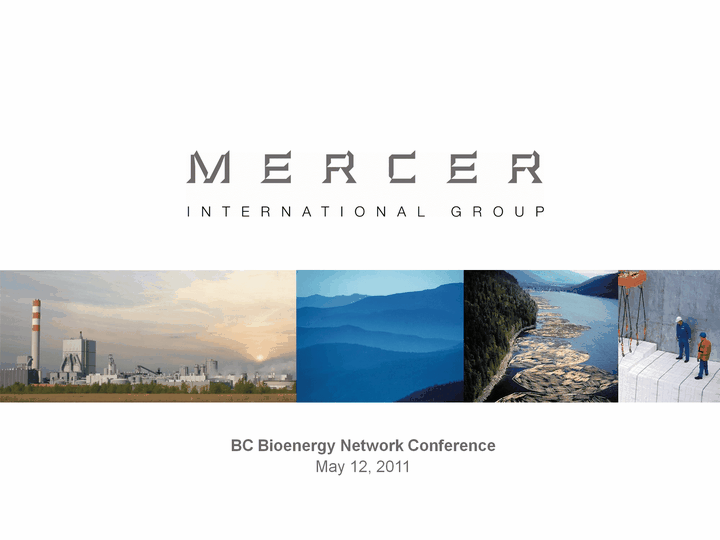
| BC Bioenergy Network ConferenceMay 12, 2011 |
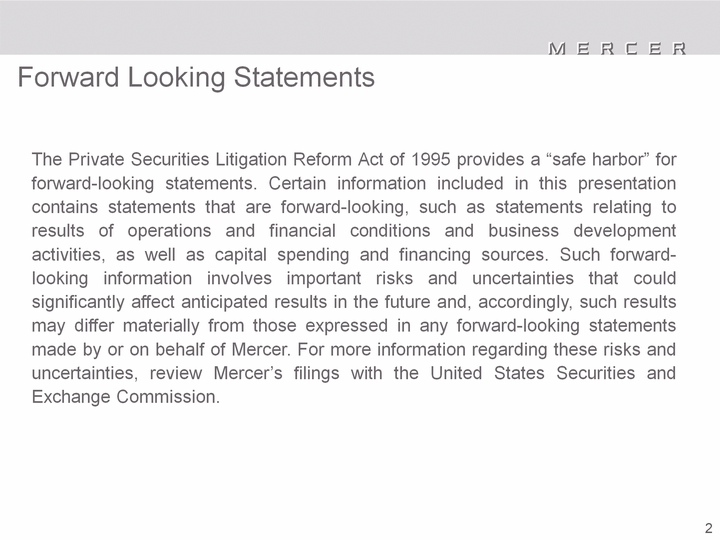
| The Private Securities Litigation Reform Act of 1995 provides a "safe harbor" for forward-looking statements. Certain information included in this presentation contains statements that are forward-looking, such as statements relating to results of operations and financial conditions and business development activities, as well as capital spending and financing sources. Such forward- looking information involves important risks and uncertainties that could significantly affect anticipated results in the future and, accordingly, such results may differ materially from those expressed in any forward-looking statements made by or on behalf of Mercer. For more information regarding these risks and uncertainties, review Mercer's filings with the United States Securities and Exchange Commission. Forward Looking Statements |
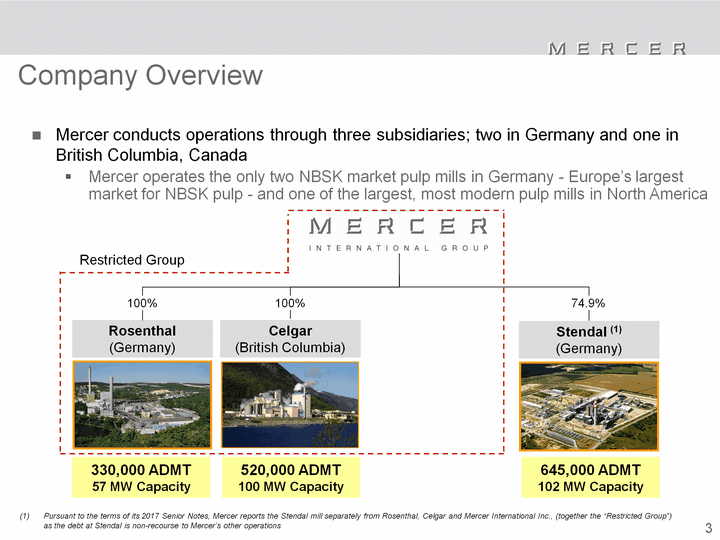
| Mercer conducts operations through three subsidiaries; two in Germany and one in British Columbia, CanadaMercer operates the only two NBSK market pulp mills in Germany - Europe's largest market for NBSK pulp - and one of the largest, most modern pulp mills in North America Company Overview Rosenthal (Germany) Celgar (British Columbia) Stendal (1) (Germany) 74.9% Restricted Group 100% 100% Pursuant to the terms of its 2017 Senior Notes, Mercer reports the Stendal mill separately from Rosenthal, Celgar and Mercer International Inc., (together the "Restricted Group") as the debt at Stendal is non-recourse to Mercer's other operations 520,000 ADMT 100 MW Capacity 330,000 ADMT 57 MW Capacity 645,000 ADMT 102 MW Capacity |
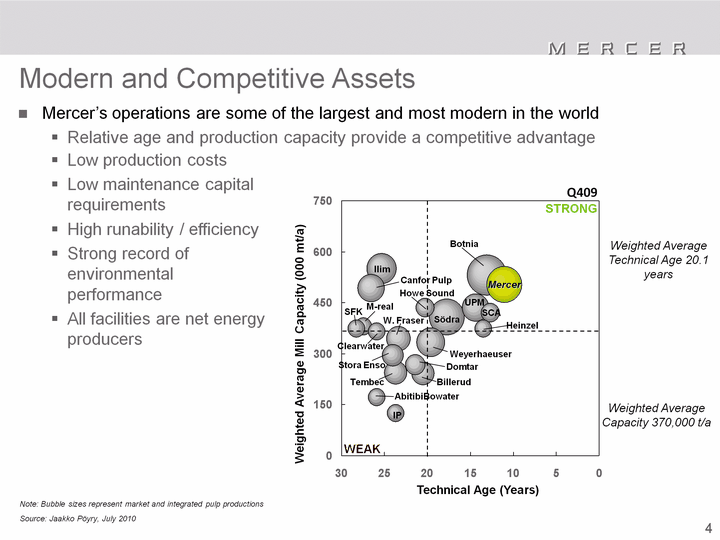
| Modern and Competitive Assets Mercer's operations are some of the largest and most modern in the worldRelative age and production capacity provide a competitive advantage Note: Bubble sizes represent market and integrated pulp productions Source: Jaakko Poyry, July 2010 Low production costsLow maintenance capital requirementsHigh runability / efficiencyStrong record of environmental performanceAll facilities are net energy producers X axis Company Comment Botnia Size 1 Sodra Size 2 Mercer Size 3 Ilim Pulp Size 4 Weyerhaeuser Size 5 Canfor Size 6 UPM Size 7 West Fraser Size 8 Billerud Size 9 Tembec Size 10 Stora Enso Size 11 Domtar Size 12 Howe Sound Size 13 SCA Size 14 M-real Size 15 Heinzel Size 16 SFK Pulp Size 17 Clearwater Size 18 AbitibiBowater Size 19 International Paper Size 20 Dots for lines W.Avg Cap 30 Horisontal line 370 0 0 Horisontal line 370 0 20.1 Vertical Line 800 0 20.1 Vertical Line 0 0 Units 13.1 Botnia 531.1 1865 17.7 Sodra 407.1 1455 11 Mercer 504 1420 25.3 Ilim Pulp 549.9 995 19.6 Weyerhaeuser 333.9 980 26.6 Canfor 493.6 900 14.4 UPM 435.1 870 23.4 West Fraser 345.1 690 20.5 Billerud 241.6 645 23.7 Tembec 244.2 590 24 Stora Enso 295.1 525 21.4 Domtar 268 490 20.3 Howe Sound 435 435 12.7 SCA 420 420 27.5 M-real 380 380 13.5 Heinzel 375 375 28.3 SFK Pulp 375 375 25.9 Potlatch 365 365 25.9 AbitibiBowater 172.5 345 23.7 International Paper 124.6 335 Technical Age (Years) Weighted Average Technical Age 20.1 years Weighted Average Mill Capacity (000 mt/a) Weighted Average Capacity 370,000 t/a Q409 STRONG Sodra Weyerhaeuser Tembec SCA W. Fraser Ilim Domtar Mercer Canfor Pulp Botnia UPM Howe Sound Heinzel Billerud IP Stora Enso Clearwater AbitibiBowater SFK M-real WEAK |
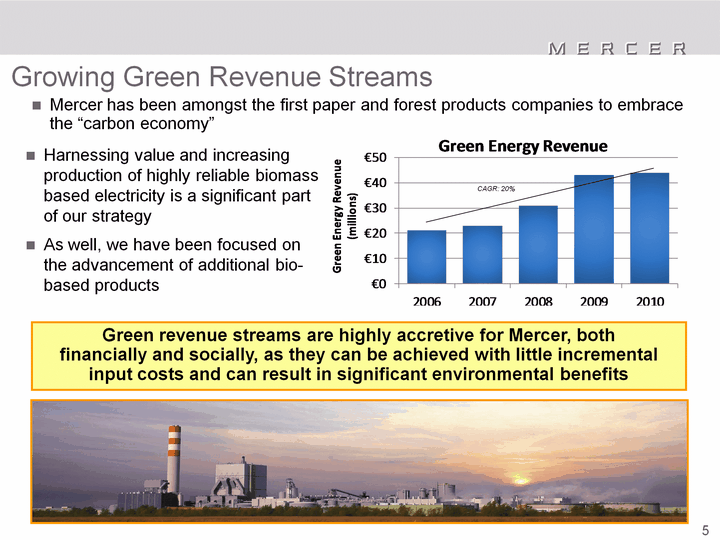
| Growing Green Revenue Streams Harnessing value and increasing production of highly reliable biomass based electricity is a significant part of our strategyAs well, we have been focused on the advancement of additional bio- based products CAGR: 20% Mercer has been amongst the first paper and forest products companies to embrace the "carbon economy" Green revenue streams are highly accretive for Mercer, both financially and socially, as they can be achieved with little incremental input costs and can result in significant environmental benefits |
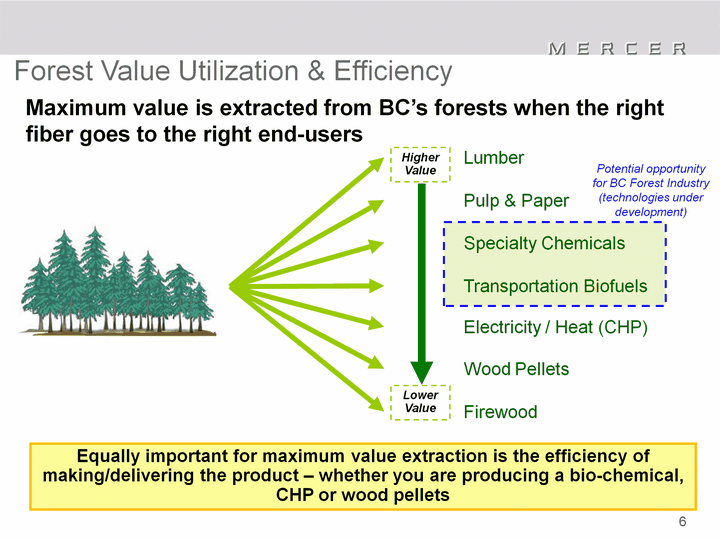
| Maximum value is extracted from BC's forests when the right fiber goes to the right end-users Lumber Pulp & Paper Specialty Chemicals Transportation Biofuels Electricity Wood Pellets Firewood Lumber Pulp & Paper Specialty Chemicals Transportation Biofuels Electricity / Heat (CHP) Wood Pellets Firewood Higher Value Lower Value Potential opportunity for BC Forest Industry (technologies under development) Equally important for maximum value extraction is the efficiency of making/delivering the product - whether you are producing a bio-chemical, CHP or wood pellets Forest Value Utilization & Efficiency |
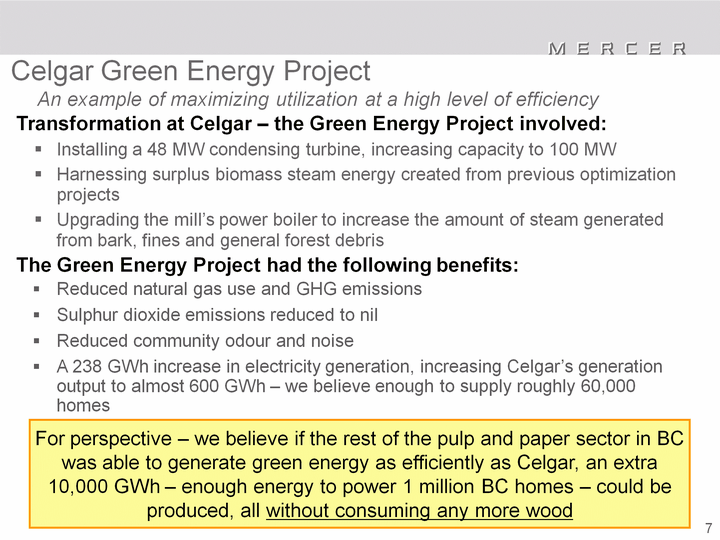
| Celgar Green Energy Project An example of maximizing utilization at a high level of efficiency Transformation at Celgar - the Green Energy Project involved: Installing a 48 MW condensing turbine, increasing capacity to 100 MW Harnessing surplus biomass steam energy created from previous optimization projects Upgrading the mill's power boiler to increase the amount of steam generated from bark, fines and general forest debris Reduced natural gas use and GHG emissionsSulphur dioxide emissions reduced to nilReduced community odour and noiseA 238 GWh increase in electricity generation, increasing Celgar's generation output to almost 600 GWh - we believe enough to supply roughly 60,000 homes The Green Energy Project had the following benefits: For perspective - we believe if the rest of the pulp and paper sector in BC was able to generate green energy as efficiently as Celgar, an extra 10,000 GWh - enough energy to power 1 million BC homes - could be produced, all without consuming any more wood |
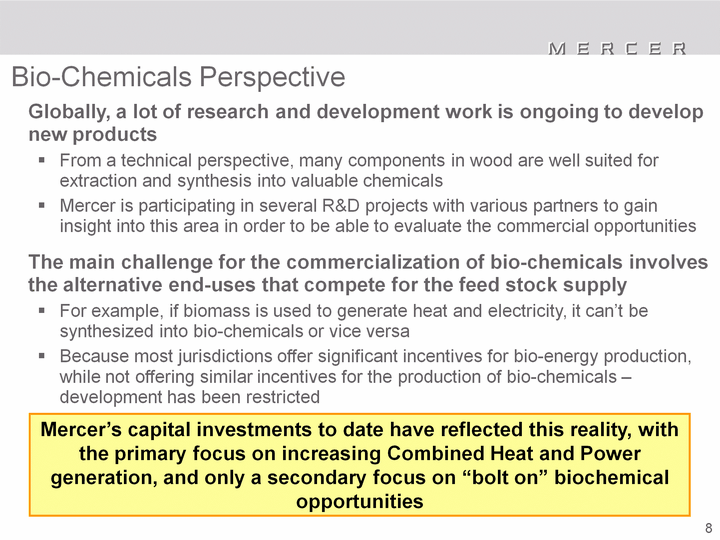
| Bio-Chemicals Perspective Globally, a lot of research and development work is ongoing to develop new productsFrom a technical perspective, many components in wood are well suited for extraction and synthesis into valuable chemicalsMercer is participating in several R&D projects with various partners to gain insight into this area in order to be able to evaluate the commercial opportunitiesThe main challenge for the commercialization of bio-chemicals involves the alternative end-uses that compete for the feed stock supplyFor example, if biomass is used to generate heat and electricity, it can't be synthesized into bio-chemicals or vice versaBecause most jurisdictions offer significant incentives for bio-energy production, while not offering similar incentives for the production of bio-chemicals - development has been restricted Mercer's capital investments to date have reflected this reality, with the primary focus on increasing Combined Heat and Power generation, and only a secondary focus on "bolt on" biochemical opportunities |
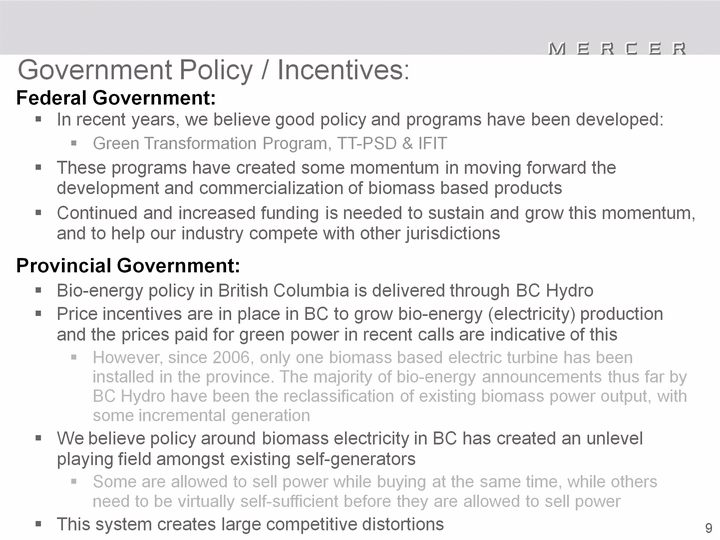
| Government Policy / Incentives: Federal Government: In recent years, we believe good policy and programs have been developed:Green Transformation Program, TT-PSD & IFITThese programs have created some momentum in moving forward the development and commercialization of biomass based productsContinued and increased funding is needed to sustain and grow this momentum, and to help our industry compete with other jurisdictions Provincial Government: Bio-energy policy in British Columbia is delivered through BC HydroPrice incentives are in place in BC to grow bio-energy (electricity) production and the prices paid for green power in recent calls are indicative of thisHowever, since 2006, only one biomass based electric turbine has been installed in the province. The majority of bio-energy announcements thus far by BC Hydro have been the reclassification of existing biomass power output, with some incremental generationWe believe policy around biomass electricity in BC has created an unlevel playing field amongst existing self-generatorsSome are allowed to sell power while buying at the same time, while others need to be virtually self-sufficient before they are allowed to sell power This system creates large competitive distortionsThese programs have created some momentum in moving forward the development / commercialization of biomass based products.Continued and increased funding is needed to maintain and increase the momentum as well as compete with other jurisdictions. |
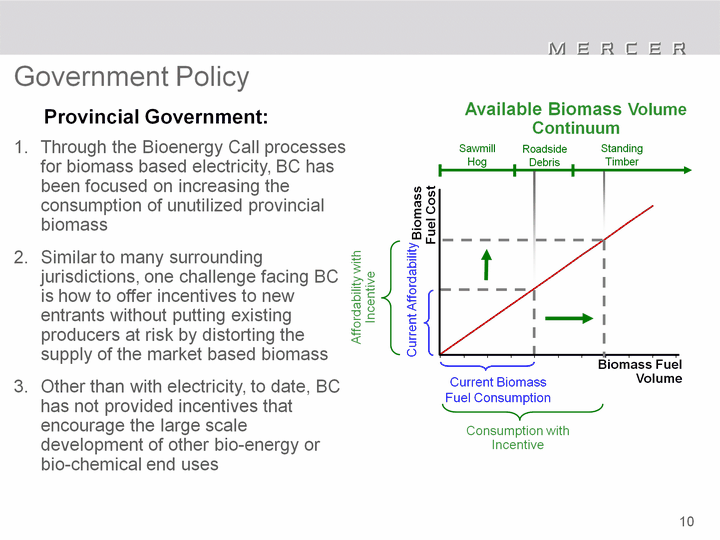
| Provincial Government: Current Affordability Affordability with Incentive Current Biomass Fuel Consumption Consumption with Incentive Sawmill Hog Roadside Debris Available Biomass Volume Continuum Biomass Fuel Cost Biomass Fuel Volume Standing Timber Through the Bioenergy Call processes for biomass based electricity, BC has been focused on increasing the consumption of unutilized provincial biomassSimilar to many surrounding jurisdictions, one challenge facing BC is how to offer incentives to new entrants without putting existing producers at risk by distorting the supply of the market based biomassOther than with electricity, to date, BC has not provided incentives that encourage the large scale development of other bio-energy or bio-chemical end uses Government Policy |
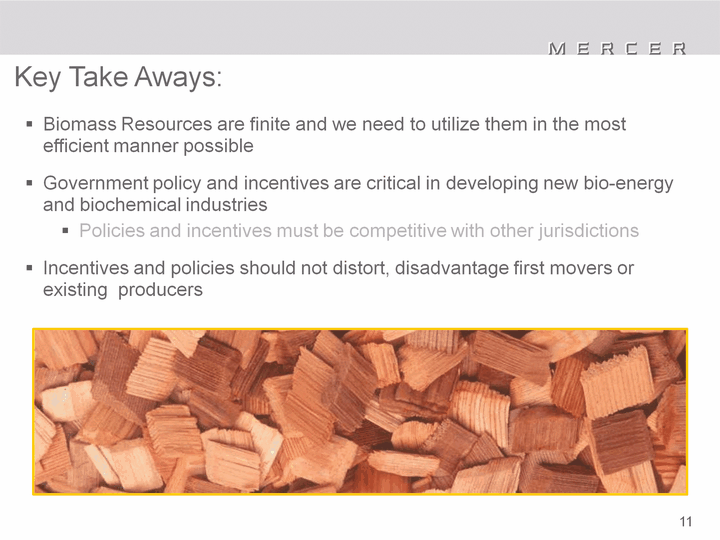
| Biomass Resources are finite and we need to utilize them in the most efficient manner possibleGovernment policy and incentives are critical in developing new bio-energy and biochemical industriesPolicies and incentives must be competitive with other jurisdictionsIncentives and policies should not distort, disadvantage first movers or existing producers Key Take Aways: |
